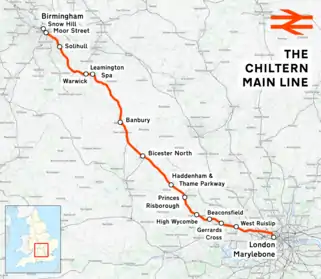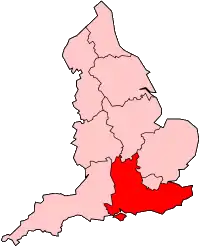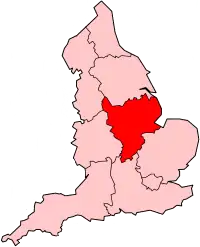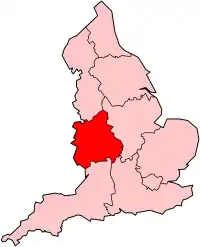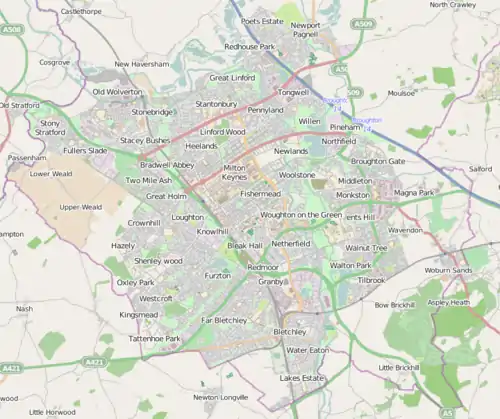Chiltern Main Line
The Chiltern Main Line is an inter-urban, regional and commuter railway, part of the British railway system. It links London (Marylebone) and Birmingham (Moor Street and Snow Hill), the United Kingdom's two largest cities, by a 112-mile (180 km) route via High Wycombe, Banbury, and Leamington Spa.
| Chiltern Main Line | |||
|---|---|---|---|
.jpg.webp) Chiltern Railways London to Birmingham express, hauled by a Class 68 diesel locomotive. | |||
| Overview | |||
| Status | Operational | ||
| Owner | Network Rail | ||
| Locale | |||
| Termini | London Marylebone Birmingham Snow Hill | ||
| Stations | 32 | ||
| Service | |||
| Type | Commuter rail, Heavy rail | ||
| System | National Rail | ||
| Operator(s) |
| ||
| Rolling stock | |||
| History | |||
| Opened | 1910 (complete line) | ||
| Technical | |||
| Line length | 112 mi 4 chains (180 km) | ||
| Number of tracks | 2 | ||
| Track gauge | 4 ft 8 1⁄2 in (1,435 mm) standard gauge | ||
| Operating speed | 100 mph (160 km/h) maximum | ||
| |||
It is one of two main line railway routes between London and Birmingham, the other being the West Coast Main Line between London Euston and Birmingham New Street, which is the principal InterCity route between the two cities.
The name Chiltern Line was invented as a marketing name for the line by Network SouthEast in 1985,[1] in reference to the Chiltern Hills which the route passes through near its southern end. The route was originally part of the Great Western Railway's main line from London Paddington to Birmingham Snow Hill, Wolverhampton Low Level and Birkenhead Woodside. Most main line services between London and Birmingham on this route were discontinued in 1967 after the West Coast Main Line was electrified, and Snow Hill station was closed.[2] Services were resumed between London and the reopened Snow Hill in 1993, however they were routed into Marylebone, formerly the London terminus of the now-closed Great Central Main Line, instead of the historic terminus at Paddington.[3]
Since the privatisation of British Rail in the 1990s, the main operator has been Chiltern Railways who have continued to develop the route and services. The line has undergone a major upgrade which has seen much of the line cleared for 100 mph (160 km/h) running, resulting in significant reductions in journey times from 2013. The line is not electrified, although electrification is an aspiration.[4]
The line forms part of the suburban rail networks in both cities. The majority of towns towards the London end of the route are prosperous suburbs or commuter-belt towns, such as Ruislip, Gerrards Cross and Beaconsfield. These have a journey time of 30 minutes or less to London Marylebone. In the West Midlands it is one of the Snow Hill Lines. Commuter trains operated by West Midlands Trains run between Birmingham Snow Hill, Solihull and Leamington Spa, also to Stratford-upon-Avon.
History
Early history
The original Great Western Railway (GWR) line from London Paddington to Birmingham was completed in 1852; in 1854 it was extended to Wolverhampton.[5] It ran via the Great Western Main Line to Didcot and then via Oxford and Leamington Spa. Being circuitous, it could not compete with the London and North Western Railway's London-Rugby-Birmingham route on journey times.
The only open segments of the Chiltern Main Line were the Aynho–Banbury–Leamington–Birmingham route and the single-track Wycombe Railway between Princes Risborough and High Wycombe; the latter continued south via Bourne End to Maidenhead on the Great Western Main Line.
GW/GC Joint Line
In an attempt to compete with the LNWR's London–Birmingham route and speed up goods traffic between London and the west-coast port at Birkenhead, the GWR took advantage of its partnership with the Great Central Railway (GCR) to build a new, direct Great Western and Great Central Joint Railway (the companies were already working together on a link between Woodford Halse station and Banbury). This enabled the GCR to run faster services than had been possible on the Metropolitan Railway route through Aylesbury and Amersham, which was congested with stopping trains.
The Joint line started at Northolt Junction in Middlesex, from which two lines ran southward:
- the direct "New North Main Line" (present-day Acton–Northolt line) towards London Paddington via Greenford and Old Oak Common, built by the GWR. This included a triangular junction at Greenford, providing access to the Great Western Main Line via Castle Bar Park;
- a line via South Harrow and Wembley to the GCR at Neasden Junction, near Neasden station on what is now the Jubilee line, used by almost all Chiltern trains. It was authorised by a GCR Act of 12 August 1898,[6] being opened on 2 April 1906.[7]
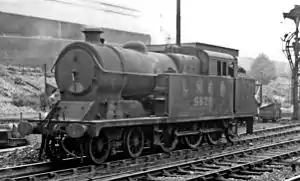
The Joint line ran northwest via Gerrards Cross to High Wycombe, where it met the Wycombe Railway's single-track branch from Maidenhead to Aylesbury via Princes Risborough. North of High Wycombe this line was followed, with significant upgrading of the formation, including dualling and a new alignment for the up line north of Saunderton. The original route, now the down line, has a gradient of 1 in 88, which was too steep for the heavy coal trains run by the GCR. As a result, the two tracks are horizontally and vertically separated, with the down line crossing the Chiltern Hills at the Risborough gap and the up line passing through an 88-yard (80 m) tunnel on a flatter gradient.
On reaching Princes Risborough, new construction started. The station was already a major junction, with the single-track line dividing into three branches: to Chinnor and Watlington (which survives in part as the Chinnor and Princes Risborough Railway); to Thame, Wheatley and Oxford; and to Aylesbury. The joint line was constructed in the 'V' formed by the two latter branches, and ran north west to Ashendon (not yet a junction), where the line curved north to join the GCR's pre-1906 main line at Grendon Underwood Junction in Buckinghamshire.
The Joint Line was completed in 1906 (with portions opening earlier) by the GWR and immediately benefited both parties. The GCR, unable to secure adequate access to its route via Aylesbury, Amersham and Harrow, gained a new and fast bypass route for its express passenger and freight trains between London and the East Midlands, while the GWR gained a faster route for its Birmingham trains, from Paddington via Gerrards Cross and Princes Risborough and then temporarily (1906–1910) on to the Wycombe Railway via Thame to regain their original route at Oxford, pending the opening of the Bicester cut-off to Banbury (see next subsection). GCR expresses non-stop between London and Rugby could now use either the Metropolitan route or the Joint Line, while the Joint Line was used by GWR expresses from Paddington to Birmingham and Wolverhampton and on to Shrewsbury and Mid/North Wales, Chester and Birkenhead.
The Bicester cut-off
Four years later, in 1910, the GWR completed a line from what became Ashendon Junction (a flying junction) north west via Bicester to meet the line from Oxford at Aynho Junction. This meant that the Joint Line from Ashendon Junction to Grendon Underwood became GCR-only, and was sold to the GCR. The cut-off gave the GWR a faster route between London and Birmingham, avoiding Oxford; the final saving in distance was about 20 miles (32 km).
Heyday, decline and rationalisation
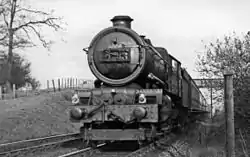
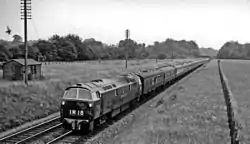
During the heyday of the route, many prestigious trains ran from Paddington to the northwest of England via the Joint Line, reaching Wolverhampton, Shrewsbury, Wrexham General, Chester and Birkenhead Woodside. Various through services from Marylebone to the GCR network also ran via the Joint Line between London and Ashendon Junction.
At nationalisation in 1948, the line passed to the Western Region of British Railways, which continued to operate Paddington – Birmingham – Wolverhampton - Birkenhead fast trains through the 1950s in competition with the London Midland Region's (LMR) from Euston via the West Coast Main Line (WCML).
The Paddington – Birmingham – Wolverhampton - Birkenhead fast service was sharply increased in frequency to up to 15 trains a day each way from the 1959–60 timetable to compensate for the withdrawal of most LMR trains during electrification of the WCML.[8] For the same reason, the Chiltern line was used by many trains between Paddington and Birkenhead from 1965.
All local trains were diverted to Marylebone in 1963 and operated by four-car Class 115 DMUs, and the main-line platforms at Greenford on the New North route between Old Oak Common and Northolt Junction were closed.
After the GCR main line was closed between Calvert and Rugby Central in September 1966, some trains from the South Coast were diverted north of Banbury via the route. These became the forerunners of today's CrossCountry services between Birmingham and Bournemouth.
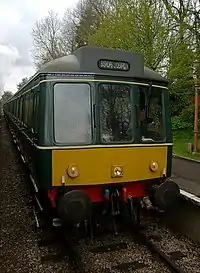
On 6 March 1967,[9] after completion of the WCML electrification, express trains from Paddington to Birmingham/Wolverhampton/Birkenhead were discontinued under The Reshaping of British Railways. The route was downgraded to secondary status and subsequently single-tracked between Princes Risborough and Aynho Junction, which remained a flying junction, with a crossing loop at Bicester not normally used. Through lines were removed from most of those stations which had them, such as Denham in 1965, Beaconsfield in 1973 and Gerrards Cross in 1989 and the relief lines were lifted between Lapworth and Tyseley. The tunnel between Birmingham Moor Street and Snow Hill closed on 2 March 1968.[9] Local services from Leamington and Stratford terminated at Moor Street, and the remaining services from Paddington and the South Coast were diverted into New Street. Snow Hill closed completely, along with most of the line to Wolverhampton, on 4 March 1972.[9]
Although a two-hourly locomotive-hauled semi-fast service from Paddington to Birmingham continued via High Wycombe, Princes Risborough, Bicester, Banbury, Leamington and Solihull, in the early 1970s all but one daily peak-hour return journey were diverted via Reading and Oxford, and later via Coventry, and in the 1980s that was truncated to run to Banbury only. All other passenger services were operated by DMUs to and from Marylebone, extended from High Wycombe to Banbury (for connections to Birmingham), on a two-hourly frequency.
On 24 March 1974 the line from Marylebone to Banbury transferred from the Western Region to the London Midland Region and all stations between South Ruislip and Bicester were also transferred to LMR giving LMR the responsibility of all passenger services out of Marylebone.
In 1977 the Parliamentary Select Committee on Nationalised Industries recommended considering electrification of more of the rail network, and by 1979 BR presented a range of options to electrify numerous routes by 2000.[10] Some of these options included the Banbury – Birmingham section of the line, plus the Cherwell Valley Line and the Coventry to Leamington line.[10] Under the 1979–90 Conservative governments that succeeded the 1976–79 Labour government the proposals were not implemented.
The route was considered for partial closure in the 1980s. All services would have run to Paddington via the New North route, and Marylebone station and all lines leading to it would have been closed. Services to and from Aylesbury would have run via Princes Risborough. However, Marylebone was formally reprieved in 1986 and the closure proposals rescinded.
Between 1988 and 1992 British Rail carried out a total route modernisation which included resignalling from Marylebone to Aynho Junction, and both Marylebone to Aylesbury routes, from the new Marylebone Integrated Control Centre. This was combined with track rationalisation that removed most of the vestigial traces of main-line heritage from the line, downgrading it to a purely commuter line with a minimal infrastructure. Until then, much of the four-track section between Northolt Junction and West Ruislip had survived, and High Wycombe station had retained almost all of its original track layout, though the other major stations on the line had already been downgraded with their through lines removed. At the same time, the New North route between Old Oak Common and Northolt Junction was singled between Old Oak Common and Park Royal and between Greenford and Northolt Junction. In 1992, the signal box at Aynho Junction was closed and replaced with modern signalling controlled from Banbury South signal box; the box was demolished in 2002. As part of these renovations, BR installed the advanced Automatic Train Protection (ATP) system, mainly as a trial with a view to rolling it out nationwide. However, privatisation intervened, and the Great Western Main Line was the only other line to be so equipped.
Rejuvenation

With Sectorisation of British Rail in the mid-1980s, operations south of Banbury fell under the control of Network SouthEast in 1986, under the Thames & Chiltern sub-sector, later split into two constituent parts. In 1987 a new station was opened at Haddenham & Thame Parkway. Birmingham Snow Hill reopened in 1987 on a much smaller scale than the original, beneath a multi-storey car park, with its tunnel reinstated and new platforms on the through lines at Moor Street, where the terminus was taken out of use, with Leamington/Stratford services diverted to Snow Hill.
The opening of the extension of the parallel M40 motorway from Oxford to Birmingham in 1991 spawned development in towns along the northern section of the route, notably Bicester, Banbury, Leamington Spa and Warwick. This generated additional patronage for train services in the corridor.
Class 165 Turbo trains were introduced in 1991, initially between Marylebone and Banbury. These improved passenger comfort and enabled journey times to be reduced; frequencies were increased, with an hourly stopping service to/from High Wycombe and hourly semi-fast service to/from Banbury. In 1993, Marylebone-Banbury services were extended to Snow Hill, calling at Leamington Spa, Warwick, Solihull and Moor Street, initially on a two-hourly frequency, increased to hourly the following year, when a Dorridge call was added. In 1995 the Jewellery Line was re-opened to allow Worcester line services to be diverted from New Street to Snow Hill; this allowed some of Chiltern's weekday peak-period services to be extended beyond Snow Hill, first to Stourbridge Junction and then to Kidderminster.
Chiltern Railways era
Upon rail privatisation in 1996, the Chiltern Railways franchise was won by M40 Trains, a consortium of a management buyout, Laing Rail (a subsidiary of construction company and PFI specialist John Laing plc), and venture capitalist 3i, and in 1998 the line between Princes Risborough and Bicester North was redoubled by the company. This included the total reconstruction of Haddenham and Thame Parkway at platform level, with two side platforms instead of the single platform constructed in 1987, and a new down platform at Princes Risborough, together with the raising of the speed limit. Also in 1998 the first Class 168 Clubman trains with a 100-mile-per-hour (160 km/h) maximum speed were introduced to reduce journey times.

In 2000 Chiltern Railways opened a new station at Warwick Parkway, to the west of the town next to the A46 and close to M40 Junction 15. This was intended to be a railhead for nearby towns without a station such as Kenilworth, and for towns south of Birmingham close to the M42 with no direct rail link to London, such as Redditch and Bromsgrove. Construction was funded by Chiltern Railways with some support from Warwickshire County Council. At first only Chiltern services called there but it is now also served by London Midland.
In 2002, after Chiltern won its 20-year franchise, the line between Bicester North and Aynho Junction was also redoubled. Chiltern took over Hatton to Stratford-upon-Avon services from Thames Trains and Central Trains, with direct services between Marylebone (rather than Paddington) and Stratford. Also at this time Chiltern took over the operation of Leamington Spa, Warwick, Hatton and Lapworth stations from Central Trains, as the latter's services (now operated by London Midland) no longer operated beyond Dorridge except during weekday peak periods.
John Laing plc acquired 84% ownership of M40 Trains in 1999, buying out 3i, and was itself bought out by Henderson Investments in 2006, resulting in the sale of Laing Rail to the German national railway operator Deutsche Bahn in 2007.
The Cherwell Valley line between Banbury and Leamington Spa was resignalled during 2004, with the closure of Fenny Compton signal box and the removal of its remaining semaphore signals. The new signalling and the existing signalling in the Leamington Spa station area is controlled from the box at Leamington via a new Westcad workstation. More recently the Leamington to Birmingham section has been resignalled and is controlled from the new West Midlands ICC at Saltley (taking over the old signalling centre at Saltley) with new 4-aspect LED signals throughout. However, the manual signal boxes at Banbury North and South remained, along with some GWR lower-quadrant signals controlling the bay platforms and sidings at the station. In 2016 the station was re-modelled and re-signalled, being incorporated into the West Midlands ICC take over control as Oxford (exclusive) in 2016.[11]
Most of the route from Birmingham Snow Hill to Wolverhampton is now used by the Midland Metro light-rail system, which diverges from Network Rail's Jewellery Line at The Hawthorns.
The route between Marylebone and Leamington/Bordesley was used by open access operator Wrexham & Shropshire's services from London to Wrexham via Tame Bridge, Wolverhampton and Shrewsbury, which comprised three Mk3 coaches hauled by Class 67 diesel locomotives. Since these were neither Sprinters nor HSTs, they were restricted to lower line speeds, e.g. 60 miles per hour (97 km/h) between Princes Risborough and Bicester, and 70 miles per hour (110 km/h) between Leamington and Bordesley, although they were permitted to travel at 85 miles per hour (137 km/h) between Bicester and Aynho. Wrexham & Shropshire had negotiated with Network Rail to allow its trains to travel at higher speeds on these sections, which required it to show that they had sufficient brake force to stop from such speeds within the signal spacings.
Only the little-used line from Northolt Junction to Paddington has not been improved.
In September 2006, Chiltern completed its "Evergreen 2" upgrade project, carried out by Carillion, which realigned the track through Beaconsfield to increase non-stop speeds from 40 to 75 miles per hour (64 to 121 km/h), installed additional signals between High Wycombe and Bicester North and between Princes Risborough and Aylesbury, and added two platforms (Nos 5 and 6) at Marylebone, on the site of the daytime carriage sidings, replaced by the new Wembley Light Maintenance Depot, just south and west of Wembley Stadium station. The new platforms and partial resignalling of the station throat make it possible to run 20 trains per hour in and out of the station.
At weekends during 2008, when major engineering works were taking place on the WCML, the line was used by Virgin Trains' London Euston - Birmingham International "Blockade Buster" service via Willesden, Acton Main Line, Ealing Broadway, Greenford, High Wycombe, Banbury and Coventry, using pairs of five-car class 221 sets.
Infrastructure
Tunnels and viaducts
.jpg.webp)
There are several major civil engineering structures along the route of the Chiltern Main Line.[12][13]
The viaduct crossing the M25 between Denham Golf Club and Gerrard's Cross is especially noted as a local landmark, as for many years it has borne a graffiti slogan, "give peas a chance" painted in large white letters on the south-facing parapet.[14] The graffiti was partially removed in 2018.[15]
| Railway Structure | Length | ELR | Location |
|---|---|---|---|
| Snow Hill Tunnel | 635 yards (581 m) | DCL | South of Snow Hill station |
| Bordesley Viaduct | 38 chains (760 m) | South of Moor Street station | |
| Goods Yard Approach & Corporation Yard Viaducts | 18 chains (360 m) | Bordesley station | |
| River Avon Viaduct | 3 chains (60 m) | Between Warwick and Leamington Spa stations | |
| Leamington Viaducts / Neilson Street Viaduct | 18 chains (360 m) | East of Leamington Spa station | |
| Harbury Tunnel | 70 yards (64 m) | Between Leamington Spa and Banbury stations | |
| Aynho Flyover (Down line) | NAJ3 | Between Kings Sutton and Bicester North stations | |
| Souldern No. 2 Viaduct | 400 yards (366 m) | Between Aynho junction and Bicester North station | |
| Souldern No. 1 Viaduct | 580 yards (530 m) | ||
| Ardley Tunnel | 1,155 yards (1,056 m) | ||
| Brill Tunnel | 191 yards (175 m) | Between Bicester North and Haddenham and Thame Parkway stations | |
| River Thame Viaduct | 4 chains (80 m) | NAJ2 | North of Haddenham and Thame Parkway station |
| Saunderton Tunnel (Up line) | 83 yards (76 m) | South of Princes Risborough station | |
| Hughenden Road Viaduct | 77 yards (70 m) | North of High Wycombe station | |
| Gordon Road Viaduct | 47 yards (43 m) | Between High Wycombe and Beaconsfield stations | |
| Sir Philip Rose's Viaduct | 66 yards (60 m) | ||
| Whitehouse Tunnel | 352 yards (322 m) | ||
| 'Tesco' Covered Way (also known as Gerrards Cross Tunnel) | 350 yards (320 m) | South of Gerrards Cross station | |
| Chalfonts No. 2 Viaduct | 165 yards (151 m) | Between Gerrards Cross and Denham Golf Club stations | |
| Chalfonts No. 1 (Misbourne) Viaduct (also M25 under) | 114 yards (104 m) | ||
| River Colne Viaduct | 121 yards (111 m) | South of Denham station | |
| Grand Union Canal Viaduct | 198 yards (181 m) | ||
| South Harrow Tunnel | 204 yards (187 m) | NAJ1 | West of Sudbury Hill Harrow station |
| Kilburn Viaduct | 23 chains (460 m) | MCJ1 | North of Marylebone station |
| Hampstead Tunnel | 694 yards (635 m) | ||
| St John's Wood Tunnel | 1,606 yards (1,469 m) |
Oxford Connection
A quarter of a mile (about 0.3 km) of double track has been constructed joining the Oxford to Bicester Line at Bicester Village to the Chiltern line, allowing a new Oxford to London Marylebone service to operate, calling at Bicester Village and High Wycombe. The track between Wolvercote Tunnel (on the outskirts of Oxford) and Bicester Village has been rebuilt and a new station constructed at Water Eaton, named Oxford Parkway.[16][17] The scheme includes additional platforms at Bicester, Islip and Oxford. The Oxford line was re-opened in stages during 2015 and 2016, with services from London Marylebone to Oxford Parkway commencing in October 2015, and services through to Oxford starting on 11 December 2016.[18][19][20] The delay to the full service was due to works in the Wolvercote tunnel, which were specifically scheduled to minimise disruption to roosting bats. The upgraded track has two bi-directional tracks and headroom in the tunnel for overhead electrification to be installed at a later date.[21]
Main Line upgrade
The second part of the project upgraded the line to 100 miles per hour (160 km/h) running on 50 miles (80 km) more of track, with junctions at Neasden, Northolt and Aynho rebuilt to permit higher speeds. The 'up' through track was restored at Princes Risborough and signalled for bidirectional use, the existing 'up' line becoming a bidirectional platform loop. A new turnback siding was provided at Gerrards Cross and a new 'down' through track built from Northolt Junction to Ruislip Gardens, running alongside the 'up' line to the east of the waste transfer station; the 'down' line will continue to serve South Ruislip. Speed restrictions through Bicester North were raised to permit 100-mile-per-hour (160 km/h) running, with a new 'up' alignment and platform. Two of the original terminal platforms at Birmingham Moor Street were reopened for Chiltern services in December 2010. Accelerated services started in September 2011,[22] after being postponed due to concerns about whether the works would be completed in time.[23][24]
Thanks to the speed increases, journey times have been reduced significantly. From Marylebone, the fastest journey time to Birmingham Moor Street is now 94 minutes instead of 117 minutes.[25] The table below outlines the originally proposed peak timetable improvements as indicated by Network Rail.[26] This compares to roughly 85 minutes for the fastest Euston-Birmingham New Street trains via the West Coast Main Line.
Chiltern Railways chairman Adrian Shooter said, "This is the biggest passenger rail project for several generations not to call on the taxpayer for support. Working closely with Network Rail, we are going to create a new main line railway for the people of Oxfordshire and the Midlands. This deal demonstrates that real improvements to rail services can be paid for without public subsidy by attracting people out of their cars and on to trains."
Network Rail said its investment will be reimbursed by a 'facility charge' over the next 30 years, by Chiltern Railways, whose franchise expires in December 2021, and then by the future franchisee. The infrastructure upgrade was carried out by main contractor BAM Nuttall, in partnership with Jarvis and WS Atkins.
| Current | Evergreen 3 | |
|---|---|---|
| Gerrards Cross | 21 | 18 |
| High Wycombe | 34 | 23 |
| Princes Risborough | 41 | 32 |
| Bicester | 56 | 44 |
| Banbury | 67 | 50 |
| Leamington Spa | 85 | 67 |
| Solihull | 107 | 84 |
| Birmingham Moor Street | 117 | 92 |
Passenger services
Chiltern Railways are the main operators of the route, however parts of the line carry services by other operators: West Midlands Trains operate local services in the West Midlands area between Birmingham, Dorridge and Leamington Spa as part of the Snow Hill Lines, and CrossCountry operate some services from either Birmingham (joining the line at Bordesley junction) or Leamington (joining from the Coventry-Leamington line) and running as far as Aynho Junction where they diverge towards Oxford. Great Western Railway also operate a few services to Banbury via Oxford.
Weekday off-peak service pattern
At May 2011:
| Chiltern Railways,[27] over the whole line | |||
|---|---|---|---|
| Service | Type | Trains per hour | Notes |
| London Marylebone - Birmingham Moor Street | Fast | 2 | 1 extended to Birmingham Snow Hill |
| London Marylebone - Kidderminster | Fast/Semi-Fast (Birmingham Snow Hill to Kidderminster) | Peak | |
| London Marylebone - Banbury | Semi fast | 1 | Extended to Stratford upon Avon every 2 hours |
| London Marylebone - Bicester North | Semi-fast | 1 | |
| London Marylebone - Princes Risborough | Semi-fast | 1 | |
| London Marylebone - High Wycombe | local | 1 | |
| London Marylebone - Gerrards Cross | local | 1 | |
| Leamington Spa - Birmingham Moor Street | local | 1 | |
| Stratford-upon-Avon - Leamington Spa | Slow to Leamington Spa then semi-fast | 1 | Most extended to London Marylebone |
| West Midlands Trains,[28][29] between Birmingham Snow Hill and Dorridge, with some services extended to Leamington Spa | |||
| Service | Type | Trains per hour | Notes |
| Dorridge - Worcester Foregate St | local (semi-fast between Birmingham Snow Hill & Stourbridge Junction) | 1 | Occasionally extended to Great Malvern |
| Dorridge - Kidderminster | local (semi-fast Kidderminster to Birmingham Snow Hill (in this direction only)) | 1 | |
| Dorridge - Stourbridge Junction | local (semi-fast Birmingham Snow Hill to Stourbridge Junction (in this direction only)) | 1 | |
| Whitlocks End - Kidderminster | local (semi-fast Kidderminster to Birmingham Snow Hill (in this direction only)) | 1 | |
| Whitlocks End - Worcester Foregate St/Shrub Hill | local (semi-fast between Birmingham Snow Hill & Stourbridge Junction) | 1 | Occasionally extended to Great Malvern |
| Stratford-upon-Avon - Stourbridge Junction | local (semi-fast Birmingham Snow Hill to Stourbridge Junction (in this direction only)) | 1 | |
| Cross Country,[30] between Bordesley South Junction/Leamington Spa and Aynho Junction | |||
| Service | Type | Trains per hour | Notes |
| Bournemouth - Manchester Piccadilly | InterCity | 1 | calls at Banbury and Leamington Spa |
| Reading - Newcastle | InterCity | 1 | calls at Banbury and Leamington Spa |
| GWR,[31] between Banbury and Aynho Junction | |||
| Service | Type | Trains per hour | Notes |
| Oxford - Banbury | local | 1 every 2/3 h | Some extended to London Paddington |
Rolling stock
Passenger trains are operated by:
| Chiltern Railways | ||||||
|---|---|---|---|---|---|---|
| Class | Image | Type | Top speed | Cars per set | Built | |
| mph | km/h | |||||
| Class 165/0 Network Turbo |
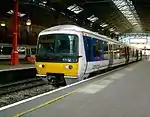 |
diesel multiple unit | 75 | 120 | 2 or 3 | 1990–1992 |
| Class 168/0 Clubman |  |
diesel multiple unit | 100 | 160 | 4 | 1998 |
| Class 168/1 Turbostar Clubman |  |
diesel multiple unit | 100 | 160 | 3 or 4 | 2000 |
| Class 168/2 Turbostar Clubman | 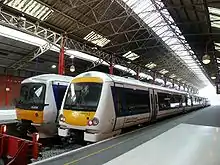 |
diesel multiple unit | 100 | 160 | 3 or 4 | 2004 |
| Class 172/1 Turbostar[32] |  |
Diesel Multiple Unit | 100 | 160 | 2 | 2011 |
| Class 68 |  |
Diesel Locomotive | 100 | 160 | N/A | 2013-2014 |
| Mark 3 Coach[33][34] | .jpg.webp) |
Passenger Coach | 125 | 200 | N/A | 1975–1984 |
 |
Driving Van Trailer | 125 | 200 | N/A | 1988 | |
| West Midlands Railway | ||||||
| Class | Image | Type | Top speed | Cars per set | Built | |
| mph | km/h | |||||
| Class 153 Super Sprinter |  |
diesel multiple unit | 75 | 121 | 1 | 1987–1988 |
| Class 170/5 Turbostar |  |
diesel multiple unit | 100 | 161 | 2 | 1999–2000 |
| Class 170/6 Turbostar |  |
diesel multiple unit | 100 | 161 | 3 | 1999–2000 |
| Class 172/2 Turbostar |  |
diesel multiple unit | 100 | 161 | 2 | 2011 |
| Class 172/3 Turbostar |  |
diesel multiple unit | 100 | 161 | 3 | 2011 |
| CrossCountry | ||||||
| Class | Image | Type | Top speed | Cars per set | Built | |
| mph | km/h | |||||
| Class 220 Voyager | 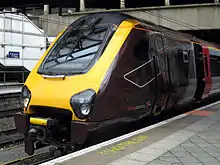 |
Diesel-electric multiple unit | 125 | 200 | 4 | 2001 |
| Class 221 Super Voyager |  |
Diesel-electric multiple unit | 125 | 200 | 4 or 5 | 2001 |
| Great Western Railway | ||||||
| Class | Image | Type | Top speed | Cars per set | Built | |
| mph | km/h | |||||
| Class 165/1 Network Turbo |  |
diesel multiple unit | 90 | 145 | 2 or 3 | 1992 |
| Class 166 Network Turbo |  |
diesel multiple unit | 90 | 145 | 3 | 1992–1993 |
Connections
Connections are available at:
- Birmingham Snow Hill, to Kidderminster and Worcester, and Midland Metro to West Bromwich and Wolverhampton.
- Birmingham Moor Street, to Stratford-upon-Avon
- Leamington Spa, to Stratford-upon-Avon, Coventry, Birmingham International, and The North
- Banbury, to Oxford, Reading, and Southampton Central
- Princes Risborough, to Aylesbury
- West Ruislip/South Ruislip, to the LU Central line to Oxford Circus
- London Marylebone, to Aylesbury and the LU Bakerloo line to Oxford Circus
Birmingham New Street, Birmingham's main station, is a 5-minute walk from Moor Street; Baker Street, where several London Underground lines call, is a 5-minute walk from London Marylebone.
Future
Electrification
No section of the line is electrified, but in 2010 the then chairman of Chiltern Railways, Adrian Shooter, indicated that electrification was being considered, though not in the immediate future. He added: "We could do some very interesting things with high-acceleration EMUs and possibly some further infrastructure work".[4]
Other plans
There are several proposals:
- The restoration of the quadruple track between South Ruislip and West Ruislip, allowing trains to call at both stations without blocking the line. Triple track currently exists at West Ruislip, with the up platform loop still in situ, and at South Ruislip, with the Down Main through line in situ. This would involve the reconstruction of the down platform at West Ruislip, the reconstruction of the up platform at South Ruislip, and the demolition of West Ruislip signal box.
- Building of a new combined West Hampstead Interchange, bringing together what at present are three close by, but physically separated stations to allow easy interchange with the London Overground (North London Line), London Underground (Jubilee line) and Thameslink (Thameslink line) and Chiltern Railways, with new Metropolitan line platforms possible.[35]
References
- "NSE CHRONOLOGY Jan 1982 to May 1986". Network SouthEast Railway Society. Archived from the original on 4 November 2013. Retrieved 22 April 2014.
- "Birmingham Snow Hill Station - A brief overview". Warwickshire Railways. Retrieved 5 June 2016.
- "The History of Network South East 1993". Network South East Railway Society. Archived from the original on 3 November 2013. Retrieved 5 June 2016.
- Broadbent, Steve (5 May 2010). "Happy Ever After". RAIL. Peterborough. p. 16.
- MacDermot, E.T. (1927). History of the Great Western Railway, volume I 1833-1863. London: Great Western Railway; Reprinted 1982, Ian Allan. pp. 327, 336. ISBN 0-7110-0411-0.
- Dow, George (1962). Great Central, Volume Two: Dominion of Watkin, 1864-1899. Shepperton: Ian Allan. pp. 302, 306. ISBN 0-7110-1469-8.
- Dow, George (1965). Great Central, Volume Three: Fay Sets the Pace, 1900-1922. Shepperton: Ian Allan. p. 107. ISBN 0-7110-0263-0.
- "The winter timetables of British Railways: Western Region". Trains Illustrated. Hampton Court: Ian Allan. December 1959. p. 584.
- Collins, Paul (1990). Rail Centres: Wolverhampton. London: Ian Allan. ISBN 978-0-7110-1892-1.
- Anonymous (Winter 1979). Railway Electrification. British Railways Board (Central Publicity Unit). pp. 0–2, 8.
- "Orange army upgrades railway and keeps customers moving in 2016". Retrieved 19 May 2017.
- Bridge, Mike (2010). Railway Track Diagrams Book 3 Western. Bradford on Avon: Trackmaps. pp. 13, 18 19. ISBN 978-0-9549866-6-7.
- Bridge, Mike (2013). Railway Track Diagrams Book 4 Midlands & North West. Bradford on Avon: Trackmaps. pp. 14, 15. ISBN 978-0-9549866-7-4.
- Winterman, Tom de Castella and Denise (25 May 2011). "Campaigning by graffiti". BBC News. Archived from the original on 20 September 2018. Retrieved 20 September 2018.
- Clifton, Katy (20 September 2018). "Motorists devastated as iconic 'Give Peas a Chance' graffiti is erased". Evening Standard. Archived from the original on 20 September 2018. Retrieved 20 September 2018.
- "Chiltern Mainline". Chiltern Railways. Archived from the original on 15 April 2010. Retrieved 23 January 2010.
- "Chiltern Railways names new Oxfordshire station Oxford Parkway" (Press release). Chiltern Railways. 20 September 2013. Archived from the original on 21 September 2013. Retrieved 20 September 2013.
- "Oxford to London Marylebone railway line opens". BBC News. 12 December 2016. Retrieved 12 December 2016.
- "Chiltern's Oxford city centre-London services pushed to December".
- "Oxford to London line". Chiltern Railways. Retrieved 13 April 2015.
- "Wolvercote Tunnel". Bicester to Oxford collaboration. Retrieved 13 April 2015.
- "Chiltern Mainline FAQ". Chiltern Railways. Archived from the original on 12 April 2015. Retrieved 13 April 2015.
- "Chiltern Railways plan to make Bicester well connected". RailNews. Stevenage. 29 August 2008. Retrieved 7 September 2008.
- "Project Evergreen 3". Chiltern Railways. 2010. Archived from the original on 28 August 2009.
- "Chiltern Railways Mainline is Here". Chiltern Railways.
- "73rd Supplemental Agreement". Network Rail.
- "Chiltern Railways May 2011 timetable" (PDF). 22 May 2011. Retrieved 25 June 2011.
- "London Midland Stratford-Birmingham May 2011 timetable". 22 May 2011. Archived from the original on 2 October 2011. Retrieved 25 June 2011.
- "London Midland Worcester-Birmingham May 2011 timetable". 22 May 2011. Archived from the original on 2 October 2011. Retrieved 25 June 2011.
- "CrossCountry South Coast - Manchester/North East May 2011 timetable" (PDF). 22 May 2011. Archived from the original (PDF) on 23 March 2012. Retrieved 25 June 2011.
- "First Great Western Banbury - Oxford May 2011 timetable" (PDF). 22 May 2011. Archived from the original (PDF) on 18 May 2011. Retrieved 25 June 2011.
- "Angel Trains orders 'green trains' for the UK rail market" (Press release). Angel Trains. 31 January 2008.
- "Passenger Board Annual Report 08/09" (PDF). Chiltern Railways. 24 June 2009. Archived from the original (PDF) on 29 December 2009.
- "Coaching Stock Design Contract for Chiltern Railways". Railway Technology. 21 July 2009.
- "Planning Framework for West Hampstead Interchange Area Appendix 2". London Borough of Camden. 19 April 2005. p. 25. Archived from the original on 11 June 2011. Retrieved 29 July 2008.
